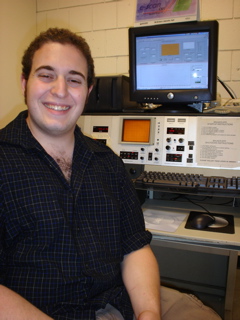EPR/ESR SPECTROSOPY
Electron Paramagnetic Resonance (EPR) spectroscopy, also known
as Electron Spin Resonance (ESR) spectroscopy, allows researchers to detect the
presence of compounds containing unpaired electron spins. These fall into
two groups, paramagnetic metal ions (for example, Cu2+) and radicals (for
example, stable nitroxide radicals). The spectrum of the unpaired
electron(s) can reflect interactions between the electron and atomic nuclei
(hyperfine couplings), the spin state (high or low spin), the spin-orbit
coupling (resonant field position or "g-value"), and the nearness of other
unpaired electron spins (relaxation effects). These interactions in turn
give the investigator information about the structure and composition of the
compounds. EPR/ESR spectroscopy has applications in Biochemistry,
Biophysics, Inorganic Chemistry, Physical Chemistry, and Materials Science.
Spectrometer
 |
My research group maintains a Bruker/IBM ER200D ESR
spectrometer operating at X-band (9 GHz). The TM4103 sample cavity
has a grill on the front that allows the sample to be illuminated while
recording spectra. Liquid samples are run in glass capillaries and
solids are run in standard EPR tubes or glass capillaries, depending on
the concentration of spins. Frozen solutions are run in standard
(4 mm) EPR tubes. Spectra are collected with a home-built computer
interface programmed within the National Instrument/LabView environment.
Our spectrometer can save data in both WinEPR and Microsoft Excel
formats.
|
Temperature Control
We have an excellent array of temperature control systems that
cover the temperature range 4 to 363 K (-269 to +90 ºC).
-30 to +90 ºC
We use an FTS Systems, Inc. XR401 Air Jet Sample Cooler coupled
to a quartz dewared insert from Wilmad. The temperature is monitored
directly below the sample position.
77 K Our workhorse at this temperature
is a humble but rugged finger dewar from Wilmad with a silvered reservoir.
The hold time between fills is approximately 45 minutes.
4 K to 298 K We have an ST-170 helium
flow cryostat from Janis Research Company. The temperature is monitored
directly below the sample. In addition, we can check the temperature at
the sample position using a gallium arsenide temperature sensor.
External Users
Academic and corporate investigators interesting in using this
instrument should contact Dr. Hirsh via e-mail at:
hirsh@tcnj.edu